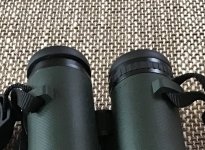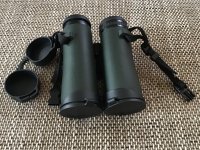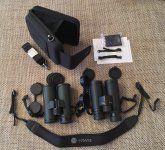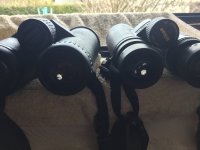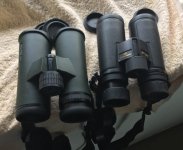Hello friends of nature and optics,
I have been reading the forum, learned a lot and selected my Nikon Monarch HG 8x42 based on your posts about 1 year ago. Now I have purchased a new binocular Hawke Frontier APO 10x42 to complement the Nikon 8x42. I want to give something back to the members of the forum and therefore wrote a comparative report. I can only use my existing Nikon Monarch HG 8x42. At places where "apples and oranges" appear, I point this out. The binoculars Nikon Monarch HG 8x42 are called Nikon MHG, the Hawke Frontier APO 10x42 is called Hawke APO. This review is very dry, a comparison report in nature is planned. English is not my native language. Forum software allowed me only 10k signs for one post. Therefore several posts.
Significant technical data (according to manufacturer) of Hawke Frontier APO 10x42:
Mass: 740 g / 26.1 oz
Eye Relief: 17 mm
IPD: 58 - 78 mm
Close focus: 2.0 m / 6.6 ft
FoV: 7.1 degrees / 124 m / 1000 m or 372ft / 1000yds
AFoV (7.1 degrees x 10): 71 degrees
AFoV (ISO 14132-1:2002): 63.6 degrees (manufacturer's specification is missing, therefore self-calculated)
Special informations from the manufacturer:
flat field vision, APO-lenses, ED-glass, dieelectric mirror coating on BAK4-prisms, water repellent lens coatings, exchangeable eyecups (twist-up), housing magnesium alloy, filled with nitrogen, waterproof (numbers or protection class according to ISO 20563 / IPX...)
Website (UK): https://uk.hawkeoptics.com/frontier-apo-10x42-binocular-green.html
Hawke Frontier APO 8x42: https://uk.hawkeoptics.com/frontier-apo-8x42-binocular-green.html
Significant technical data (according to manufacturer) of Nikon Monarch HG 10x42:
Mass: 680 g / 24 oz
Eye Relief: 17 mm
IPD: 56 - 74 mm
Close focus: 2.0 m / 6.6 ft
FoV: 6.9 degrees / 121 m / 1000 m or 362 ft / 1000yds
AFoV (6.9 degrees x 10): 69 degrees
AFoV (ISO 14132-1:2002: 62.2 degrees
Special informations from the manufacturer:
field flattener, locking diopter, waterproof 5 m / < 10 minutes (The binoculars are well known, further details unnecessary)
Website (USA): https://www.nikonusa.com/en/nikon-products/product/binoculars/monarch-hg-10x42.html
Review of allbinos.com: https://www.allbinos.com/314-binoculars_review-Nikon_Monarch_HG_10x42.html
Comparison binoculars, significant technical data (according to manufacturer) of Nikon Monarch HG 8x42:
mass: 665 g / 23.5 oz
Eye Relief: 17,8 mm
IPD: 56 - 74 mm
Close focus: 2.0 m / 6.6 ft
FoV: 8.3 degrees / 145 m / 1000 m or 435 ft / 1000yds
AFoV (8.3 degrees x 8): 66.4 degrees
AFoV (ISO 14132-1:2002): 60.3 degrees
I did not find specs from websites of both companies about dioptre compensation, overrun/overtravel to infinity for nearsighted people without spectacles / eye glasses / contact lenses and no guaranteed operating temperature range in the specifications (websites). In the enclosed certificate with serial number of the Hawke APO I can read operating temperatures from -15 to +55 degrees Celsius, waterproof to IPX7 (1 m / < 30 min). Storage temperatures from -40 to + 70 degrees Celsius. Among other things, resolution, light transmission and Strehl Ratio were ticked on in the certificate - but without numbers.
Testing of mechanics, haptics, finish and ergonomics of the Hawke APO
The armouring is not very structured but has a good grip. I was able to hold the binoculars securely even with intentionally moistened hands and could operate them well with gloves. The armouring is cleanly processed, there are no gaps, the armouring is drawn over the entire chassis. Burrs are not noticeable. The attempt to twist the reinforcement in relation to the chassis shows that the reinforcement was glued exactly and over the entire surface. I find the structuring of the reinforcement of the Nikon MHG more pleasant than the smooth reinforcement of the Hawke APO. Folding bridge and dioptre compensation are easy to operate and sufficiently inhibited so that unintentional adjustment is hardly possible. The dioptre compensation has no locking mechanism. The zero value is difficult to detect. Users with partners should apply white color dots for the special needs of two persons (setting easily repeatable for each observer). A 9-digit serial number is affixed to a plastic label under the bridge. No country of manufacture or assembly is visible. The binoculars look very simple in construction, reminds me of pre-series models. Compared to the photos on the manufacturer's website, the color of the binoculars is warmer, dark green, not so cold-green and therefore more beautiful for me than on photo by Hawke. The stirrups for the carrying strap are remarkably large and thick, edges are hardly rounded. This suggests a long durability of the stirrups - but the carrying belt (neck strap) should be checked for chafe marks from time to time. The conspicuously large and somewhat sharp-edged eyelets could bother some users when holding binoculars in the appropriate positions. However, even long camera straps with up to 12 mm wide ends will fit - and threading in straps with 10 mm wide ends is easy. The protective caps for the lenses are attached inside the tubes, which provides better protection against rain than protective caps attached to the outer surfaces of the tubes. The protective caps do not fall off as easily unintentionally as with the Nikon Monarch HG. The protective caps for objectives and eyepieces are made of soft, thin and tight-fitting rubber material. Rainguard / protective caps (inculsive rain protection for the eyepieces) are therefore more difficult to attach than with the Nikon MHG. A tripod connection is available, the whole ist closed with a plastic screw. The tubes are 7 mm longer than the outer surface of the outer objective lens (Nikon 9 mm). It is a pleasure to unpack Hawke binoculars: The accessories, especially the hard case, are of high quality. The carrying strap is contoured and can therefore be worn lower than uncontoured straps. The Hawke manufacturer's website shows the accessories well.
Focus
The Hawke APO focuses from far to near in a clockwise direction, the Nikon in the opposite direction. There is an overstroke (focus range to infinity) of the Hawke APO for short-sighted observers without glasses, I focused the moon and could see it very blurred as expected when turning further towards infinity - similar to Nikon MHG. The roller for focusing the Hawke APO has a diameter of 32 mm and unfortunately about 1 mm tangential clearance (i.e. clearance in circumference/direction of rotation). The focusing roller is 24 mm long, easy to reach and very smooth running: Astronomers and hunters who also want a fixed distance (infinity, hyperfocal distance, presumed shooting distance in the dark) can easily change the desired and preset distance by mistake. Birdwatchers with distances that need to be changed frequently will probably get along well with the ease of movement, especially since a 10x42 has a shallower depth of field than an 8x42 and therefore needs to be rotated more frequently. The smooth-running focusing supports operation with gloves. The focusing roller is equipped with two grooved, well-structured rubber rings. Focusing is very "fast", the angle of rotation over the entire rotation range is between 340 and 350 degrees, i.e. a little less than 1 revolution. The focusing runs with almost constant but low resistance (escapement, friction) and noiseless. The sharpness snaps in, either really sharp or very blurred, hardly any "nuances". On the Nikon Monarch HG 8x42 the angle of rotation over the entire range is about 570 degrees, more than 1.5 revolutions. The focusing of the Hawke APO runs with almost even inhibition (damping, friction) after some use and almost noiseless. I consider the focusing of the Nikon to be better because "slower", greater and slightly more even, constant resistance when turning over the whole range of adjustment.
I have been reading the forum, learned a lot and selected my Nikon Monarch HG 8x42 based on your posts about 1 year ago. Now I have purchased a new binocular Hawke Frontier APO 10x42 to complement the Nikon 8x42. I want to give something back to the members of the forum and therefore wrote a comparative report. I can only use my existing Nikon Monarch HG 8x42. At places where "apples and oranges" appear, I point this out. The binoculars Nikon Monarch HG 8x42 are called Nikon MHG, the Hawke Frontier APO 10x42 is called Hawke APO. This review is very dry, a comparison report in nature is planned. English is not my native language. Forum software allowed me only 10k signs for one post. Therefore several posts.
Significant technical data (according to manufacturer) of Hawke Frontier APO 10x42:
Mass: 740 g / 26.1 oz
Eye Relief: 17 mm
IPD: 58 - 78 mm
Close focus: 2.0 m / 6.6 ft
FoV: 7.1 degrees / 124 m / 1000 m or 372ft / 1000yds
AFoV (7.1 degrees x 10): 71 degrees
AFoV (ISO 14132-1:2002): 63.6 degrees (manufacturer's specification is missing, therefore self-calculated)
Special informations from the manufacturer:
flat field vision, APO-lenses, ED-glass, dieelectric mirror coating on BAK4-prisms, water repellent lens coatings, exchangeable eyecups (twist-up), housing magnesium alloy, filled with nitrogen, waterproof (numbers or protection class according to ISO 20563 / IPX...)
Website (UK): https://uk.hawkeoptics.com/frontier-apo-10x42-binocular-green.html
Hawke Frontier APO 8x42: https://uk.hawkeoptics.com/frontier-apo-8x42-binocular-green.html
Significant technical data (according to manufacturer) of Nikon Monarch HG 10x42:
Mass: 680 g / 24 oz
Eye Relief: 17 mm
IPD: 56 - 74 mm
Close focus: 2.0 m / 6.6 ft
FoV: 6.9 degrees / 121 m / 1000 m or 362 ft / 1000yds
AFoV (6.9 degrees x 10): 69 degrees
AFoV (ISO 14132-1:2002: 62.2 degrees
Special informations from the manufacturer:
field flattener, locking diopter, waterproof 5 m / < 10 minutes (The binoculars are well known, further details unnecessary)
Website (USA): https://www.nikonusa.com/en/nikon-products/product/binoculars/monarch-hg-10x42.html
Review of allbinos.com: https://www.allbinos.com/314-binoculars_review-Nikon_Monarch_HG_10x42.html
Comparison binoculars, significant technical data (according to manufacturer) of Nikon Monarch HG 8x42:
mass: 665 g / 23.5 oz
Eye Relief: 17,8 mm
IPD: 56 - 74 mm
Close focus: 2.0 m / 6.6 ft
FoV: 8.3 degrees / 145 m / 1000 m or 435 ft / 1000yds
AFoV (8.3 degrees x 8): 66.4 degrees
AFoV (ISO 14132-1:2002): 60.3 degrees
Nikon MONARCH HG 8x42 | Nikon Binoculars
MONARCH HG 8x42 binoculars provide impeccable magnification for all your outdoor needs. Shop visionary Nikon full-size binoculars!
www.nikonusa.com
I did not find specs from websites of both companies about dioptre compensation, overrun/overtravel to infinity for nearsighted people without spectacles / eye glasses / contact lenses and no guaranteed operating temperature range in the specifications (websites). In the enclosed certificate with serial number of the Hawke APO I can read operating temperatures from -15 to +55 degrees Celsius, waterproof to IPX7 (1 m / < 30 min). Storage temperatures from -40 to + 70 degrees Celsius. Among other things, resolution, light transmission and Strehl Ratio were ticked on in the certificate - but without numbers.
Testing of mechanics, haptics, finish and ergonomics of the Hawke APO
The armouring is not very structured but has a good grip. I was able to hold the binoculars securely even with intentionally moistened hands and could operate them well with gloves. The armouring is cleanly processed, there are no gaps, the armouring is drawn over the entire chassis. Burrs are not noticeable. The attempt to twist the reinforcement in relation to the chassis shows that the reinforcement was glued exactly and over the entire surface. I find the structuring of the reinforcement of the Nikon MHG more pleasant than the smooth reinforcement of the Hawke APO. Folding bridge and dioptre compensation are easy to operate and sufficiently inhibited so that unintentional adjustment is hardly possible. The dioptre compensation has no locking mechanism. The zero value is difficult to detect. Users with partners should apply white color dots for the special needs of two persons (setting easily repeatable for each observer). A 9-digit serial number is affixed to a plastic label under the bridge. No country of manufacture or assembly is visible. The binoculars look very simple in construction, reminds me of pre-series models. Compared to the photos on the manufacturer's website, the color of the binoculars is warmer, dark green, not so cold-green and therefore more beautiful for me than on photo by Hawke. The stirrups for the carrying strap are remarkably large and thick, edges are hardly rounded. This suggests a long durability of the stirrups - but the carrying belt (neck strap) should be checked for chafe marks from time to time. The conspicuously large and somewhat sharp-edged eyelets could bother some users when holding binoculars in the appropriate positions. However, even long camera straps with up to 12 mm wide ends will fit - and threading in straps with 10 mm wide ends is easy. The protective caps for the lenses are attached inside the tubes, which provides better protection against rain than protective caps attached to the outer surfaces of the tubes. The protective caps do not fall off as easily unintentionally as with the Nikon Monarch HG. The protective caps for objectives and eyepieces are made of soft, thin and tight-fitting rubber material. Rainguard / protective caps (inculsive rain protection for the eyepieces) are therefore more difficult to attach than with the Nikon MHG. A tripod connection is available, the whole ist closed with a plastic screw. The tubes are 7 mm longer than the outer surface of the outer objective lens (Nikon 9 mm). It is a pleasure to unpack Hawke binoculars: The accessories, especially the hard case, are of high quality. The carrying strap is contoured and can therefore be worn lower than uncontoured straps. The Hawke manufacturer's website shows the accessories well.
Focus
The Hawke APO focuses from far to near in a clockwise direction, the Nikon in the opposite direction. There is an overstroke (focus range to infinity) of the Hawke APO for short-sighted observers without glasses, I focused the moon and could see it very blurred as expected when turning further towards infinity - similar to Nikon MHG. The roller for focusing the Hawke APO has a diameter of 32 mm and unfortunately about 1 mm tangential clearance (i.e. clearance in circumference/direction of rotation). The focusing roller is 24 mm long, easy to reach and very smooth running: Astronomers and hunters who also want a fixed distance (infinity, hyperfocal distance, presumed shooting distance in the dark) can easily change the desired and preset distance by mistake. Birdwatchers with distances that need to be changed frequently will probably get along well with the ease of movement, especially since a 10x42 has a shallower depth of field than an 8x42 and therefore needs to be rotated more frequently. The smooth-running focusing supports operation with gloves. The focusing roller is equipped with two grooved, well-structured rubber rings. Focusing is very "fast", the angle of rotation over the entire rotation range is between 340 and 350 degrees, i.e. a little less than 1 revolution. The focusing runs with almost constant but low resistance (escapement, friction) and noiseless. The sharpness snaps in, either really sharp or very blurred, hardly any "nuances". On the Nikon Monarch HG 8x42 the angle of rotation over the entire range is about 570 degrees, more than 1.5 revolutions. The focusing of the Hawke APO runs with almost even inhibition (damping, friction) after some use and almost noiseless. I consider the focusing of the Nikon to be better because "slower", greater and slightly more even, constant resistance when turning over the whole range of adjustment.
Last edited:




